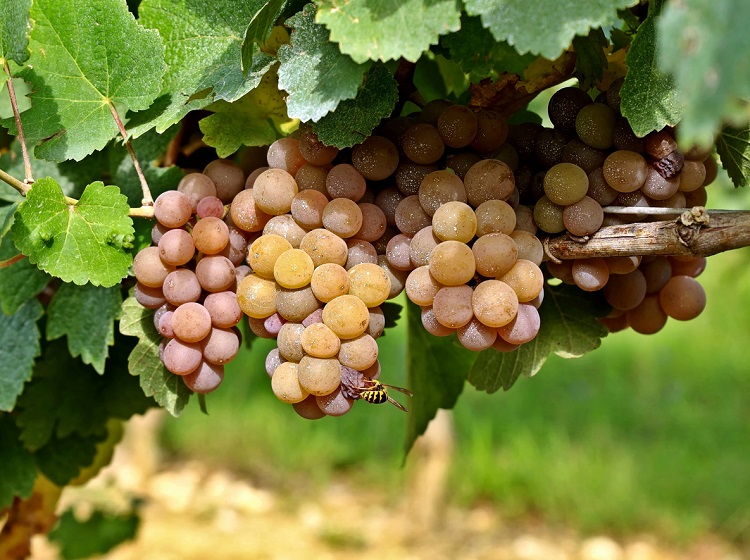Pinot Grigio Wine & Grape Variety Profile (also known as Pinot Gris)
Last Updated on April 3, 2023.
Pinot Grigio is a white wine grape variety that is made from grapes with grayish, pinkish, and or purple skins, which is where the name comes from – ‘grigio’ is ‘gray’ in Italian, as is ‘gris’ in French. The Pinot Grigio/ Gris grapes are known to be somewhat genetically unstable, so consistency in grape color is not prominent.

So why isn’t Pinot Grigio more reddish? Well, that’s because Pinot Grigio/ Gris is made from grape flesh and isn’t allowed the opportunity to meld excessively with the gray, purple, and blue skins during fermentation.
IN THIS GUIDE:
- Taste
- Pairings
- Terroir
- Aging
- Wine Recommendations
- …and more
What Does Pinot Grigio Taste Like?
Riper Pinot Grigio wines will often lean towards the side of tropical and tree fruit flavors, while less mature grapes will have more prominent hints of citrus fruit. Pinot Grigio is almost always made to be a dry white wine with either a light or medium body. Regardless of their weight, the best versions are crisp, refreshing, and well-balanced overall with moderate acidity and complex fruit flavors.
Depending on quality and production methods, there may be some versions with elevated acidity, especially in cool climate wine-growing regions.
Note that the specific taste of Pinot Grigio isn’t so simple to pin down. That’s because the ultimate flavor depends on production methods and the region the grapes are grown in.
In general, Old World Pinot Grigios will exhibit lime, lemon, pear, green apple, and peach notes while New World iterations will have passion fruit, pear, nectarine, and lime notes. Pinot Grigios also often have ginger, honey, almond, pepper, or arugula notes as well.
Some vintners also choose to utilize botrytis, which is a form of rot that causes grapes to dehydrate, while maintaining and enhancing sugar concentration.
Pinot Grigio Food Pairings
Being the lighter-bodied, crisp, and high-acid wine that it is, Pinot Grigio goes very well with a variety of seafood, grilled vegetables, and pasta dishes.
White fish works best, seasoned with lemon, lime, and butter. Chilean seabass, bluefish, haddock, tilapia, snapper, or redfish are all good choices.
Shellfish are also great, particularly oysters, either raw or fried with lemon and lime. Try utilizing ginger, oregano, cracked white and black pepper, and garlic in preparation, and marinade the seafood in the same wine that will be served with dinner.
Climate and Terroir for Pinot Grigio (Gris)
These terms are often used interchangeably these days, though Pinot Grigio is the Italian designation while Pinot Gris is the French designation. In New World plantings, it can be called either.
Italian Pinot Grigio tends to lean towards citrus and tree fruit flavors, while French Pinot Gris is sometimes more associated with tropical fruit flavors. This depends on a variety of factors, including terroir, harvest time, and styles of vinification.
That said, Pinot Grigio/Gris is a hearty and vigorous variety and thrives in a wide range of regions. It prefers warm, dry ripening so it typically is not found in colder, damper regions, like Canada or Germany.
How is Pinot Grigio Aged?
In general, Pinot Grigio is not meant to be aged. Despite its higher levels of acidity, aging will do little to improve the wine. An exception, however, is if it’s vinified as a ‘vendage tardive,’ which is a sweet late harvest wine produced in Alsace. Like most dessert wines, those can age for a decade or more.
Overall, it’s meant to be drunk soon after bottling – so pop it open and enjoy!
Try some of these Pinot Grigio wine recommendations from around the world:
- Livio Felluga, Friuli-Venezia Giulia, Italy
- Vie do Romans,’ “Dessimis,” Friuli-Venezia Giulia, Italy
- Albert Boxler, Pinot Gris Grand Cru, Alsace, France
- Domaine Emile Beyer, Pinot Gris Tradition, Alsace, France
- Acrobat, Oregon
- Ferrari-Carano, Sonoma County, California
Learn About These Other Wine Grape Varieties
Written By Jamie Metzgar
Jamie Elizabeth Metzgar began her career in wine by pouring in a tasting room on the East End of Long Island, NY. After moving to New York City, she landed a position at Chambers Street Wines where she was encouraged to pursue wine education at the Wine & Spirits Education Trust (WSET). She earned Level III certification there and has since earned California Wine Appellation Specialist and Certified Specialist of Wine certifications as well. After way too many moves, she has recently landed in Northern California where she is compiling an unofficial roster of dog-friendly tasting rooms.
Fruit
Citrus Fruit, Tree Fruit, Tropical Fruit
New World: Tropical & Tree Fruit dominant (passion fruit, pear, dragon fruit, peach, nectarine, lime)
Old World: Citrus Fruit Dominant (lime, lemon, pear, green apple, peaches)
Earth & Mineral Notes
Limestone, Clay, Sand
Additional Complexities
Ginger, Honey, Almond, Cracked Pepper, Arugula
Structure & Body
Pinot Grigio Wine Profile
Body Light-Medium
Sugar Dry
Tannins Low
Acid Medium-Plus
Alcohol (10%-14.5% ABV - Low calorie Pinot Gris can have as little as 9% ABV!)
Finish Short-Medium
[…] so the color is not always consistent, even within a single cluster of grapes on the same vine (via Wine Traveler). As a result, some Pinot Grigio grapes can be purple, white, pink, even carry a hint of brown (via […]